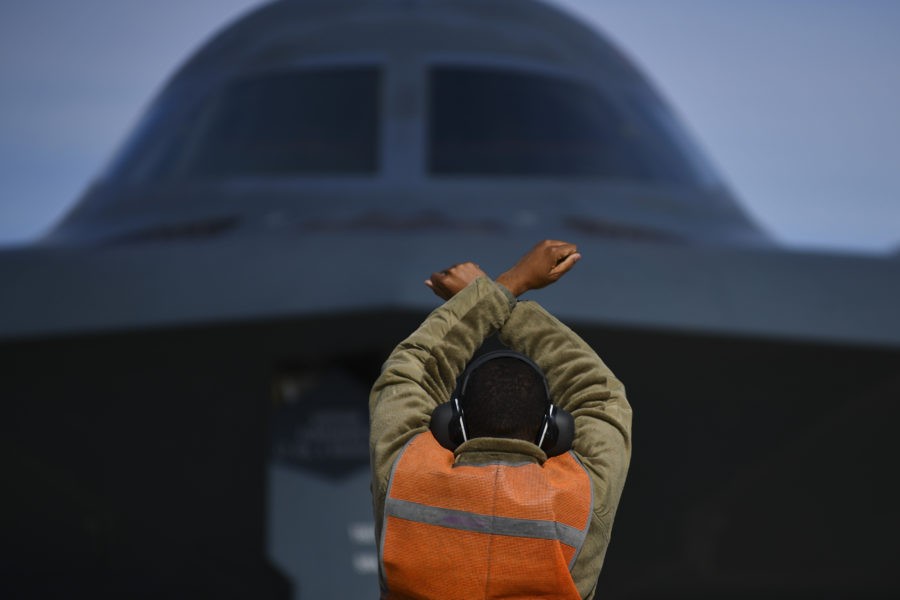Money
B-1 and B-2 Bomber Spending to Dwindle as Focus Shifts to B-21, B-52

Air Force budget documents show B-1 and B-2 bomber spending dwindling through the end of the 2020s, as the service puts priority on the new B-21 and the upgraded B-52. Though the B-1 and B-2 potentially have additional years of service, the near-cutoff in spending in the next five years could make it difficult to keep them credible into the 2030s, should Congress direct that they be retained.
Global Strike Command has said in the last few years it intends to devote its finite manpower and fiscal resources to a two-bomber force—the B-21 and B-52—and retire the B-1 and B-2, which have recorded middling mission capability rates in recent years.
From the small B-2 fleet of just 20 aircraft, GSC can muster about 14 for operations at any given time, the remainder either being in test, depot, or down for maintenance. The B-2’s stealth systems, though improved over the last decade, remain challenging and a voracious consumer of maintenance man-hours. The B-21 is expected to offer a sharp improvement in availability—a “daily flyer” as Chief of Staff Gen. Charles Q. Brown Jr. said at the aircraft’s December 2022 rollout—and require a smaller manpower footprint.
The B-1 fleet was reduced to 45 aircraft less than two years ago, although the maintenance manpower and funding for the 17 retired airplanes was retained to boost the mission capability of those that remain.
The Air Force is requesting $284.9 million for B-2 procurement over the Future Years Defense Plan, running from fiscal year 2024-28. Funding would start at $107.9 million in FY ’24, drop by almost half to $57.16 million in 2025, fall slightly in each of the next two years, and then plummet to $15.78 million in 2028. The “to completion” line in the B-2 procurement account is zero, meaning no further funding is expected to be requested beyond that point.
Research, development, test, and evaluation for the B-2 shows an even more stark dropoff, starting with $87.6 million in 2024, but again falling by more than half to $33.14 million in 2025, followed by just a few thousand dollars a year until 2028, and nothing after that.
Much of the money requested for the B-2 is to upgrade its avionics, communications systems, cockpit displays, weapons, stealth capabilities, training gear, support equipment, and supportability initiatives.
Aircraft that were modified to test the canceled Defensive Management System will be de-modified to make them consistent with the other aircraft in the fleet.
The Air Force will also “study multiple structural, avionics, and engine modifications, as well as advanced weapons integration and advanced communications, that could improve the performance of the aircraft and engines and reduce maintenance man-hours and the logistics footprint of the fleet,” the service said in its budget justification. The B-2 will also receive a cryptological upgrade.
Supportability funding will go toward identifying and fixing specific issues that “drive” non-mission capable rates, USAF said. This will help improve the availability rates for the in-demand bomber.
Funding also supports stealth improvement, called the Low Observable Signature and Supportability Modifications (LOSSM) program. These include improved a broad range of low-observable materials and structures, as well as “radio frequency (RF) diagnostic tools, evaluation systems, and other key support equipment,” the Air Force said. These investments tend to yield a high rate of return on B-2 operating costs and availability, the service noted.
Other improvements include an upgraded identification, friend or foe (IFF) system, training systems and simulator upgrades, and initiatives to address “Diminishing Manufacturing Sources” issues, where parts are hard to get because they are no longer made, or, in the case of software, where systems are at ”end of life” and no longer supportable. The Air Force wants to move toward “a modular, common open system architecture that is sustainable and cyber-resilient.”
Money that was added by Congress in fiscal year 2023 will be used to explore “commercial technologies to include autonomous robotics perimeter defense system, 5G testing support, and advanced software tools.”
The Air Force’s B-1 procurement funding request is $12.8 million in fiscal 2024, falling to $3.31 million in 2025, $4.74 million in 2027, and to around $1 million a year in 2027-28. Over the same period, more was programmed for RDT&E, with $32.68 million across the entire FYDP, but that total is front-loaded to 2024 and 2025, with only a few thousand dollars a year each in 2027 and 2028.
Budget justifications describe the B-1 as an aircraft “with an expected service life beyond 2037.”
The Air Force is constructing a “digital twin” of the B-1B to explore new sustainment technologies developed using digital methods.
Funding items include urgent radio upgrades to prevent the B-1B from losing “secure line of sight, beyond line of sight, and anti-jam communication with ground and air forces,” due to decommissioning of some forms of satellite support and other time-critical changes. Other improvements are being made to cryptological systems and, generally to address Diminishing Manufacturing Sources. Other improvements will require “significant hardware and software development and testing.”
The B-1 will also be provided with gear to carry new weapon systems—particularly, hardware and software for external carriage of hypersonic weapons, although Air Force budget documents did not specify whether those would be the AGM-183 Air-Launch Rapid Response Weapon (ARRW), which the Air Force has since said it will not pursue into production, or the Hypersonic Attack Cruise Missile being developed by Raytheon and Northrop Grumman.
Money
They Call Me «Dragon» in the Crypto Community: Dragan Pajić Remarkable Journey

In the world of cryptocurrencies, Dragan Pajić, known as «Dragon,» has emerged as a prominent figure, earning him a well-deserved reputation in the Balkans and beyond. As the largest crypto influencer in the region, serial entrepreneur, and owner of the renowned 100X Club, Dragan has empowered thousands of individuals through his informative YouTube channel, demonstrating how they can multiply their investments by 100 times in the crypto market.
Through his marketing agency, DigitalPR, which has thrived for the past decade, and his rapidly-growing herbal brand called «Bonaturo,» Dragan has made a significant impact on both the digital marketing landscape and the health industry. Famous singers, actors, and public figures have not only embraced but also endorsed his brand, cementing his position as a trusted name in the market.
Dragan Pajić entrepreneurial ventures go beyond the crypto and marketing realms. He has diversified his investment portfolio, venturing into solar power plants, properties, and unicorn projects. Currently, he is an active investor and co-founder of Daopeople, the first decentralized web 3 social media platform based in Dubai.
Exciting times lie ahead for Dragan as he prepares to launch his long-awaited 100X Crypto Academy for a global audience. This groundbreaking educational platform will equip individuals with the knowledge and skills required to navigate the crypto market successfully.
Dragan Pajić achievements have not gone unnoticed. In 2018, he was recognized as one of the ten most influential young people in Bosnia.
Having accomplished his first million-dollar milestone in his twenties, he now holds the title of the Balkans’ most influential crypto influencer.
Looking toward the future, Dragan aims to empower even more young individuals, providing them with financial freedom and education in the domains of entrepreneurship, business, crypto, and investing. His ultimate goal is to become the first founder of a unicorn company (worth over $1 billion) from the Balkan region.
Connect with Dragan Pajić on his social media channels to stay updated on his latest ventures and insights
Instagram: https://instagram.com/draganpajic1?igshid=MzRlODBiNWFlZA==
Facebook: https://www.facebook.com/draganpajic1?mibextid=LQQJ4d
Twitter: @Dragan_Pajic
Money
Meet the cheapest US states to buy a house

A new study analyzing Zillow data has found that the monthly median sale price of a house last year was more than $500,000 in Utah, California and Colorado — and more than a staggering $800,000 in Hawaii.
The study, conducted by Studio City realtors, found that Hawaii clocked in as the most expensive state in the U.S. for homebuyers. On the island, the average home price was $805,775 — hundreds of thousands of dollars more than the cheapest state on the list.
Studio City realtor Tony Mariotti noted that market turbulence contributed to a “significant increase” in house prices across the U.S.
Home prices went up nationwide in February after months of declines amid low inventory and a small uptick in demand — and experts have said they expect affordability will continue to be a problem for prospective homebuyers in the months ahead.
Here are the priciest and cheapest U.S. states to buy a home:
The most expensive states to buy a home
Eight states and Washington, D.C., saw a monthly median sale price of a house last year of $400,000 or higher, with Oregon sitting at that exact figure.
Washington state, Nevada, Montana and Washington, D.C., came in between $402,900 and $487,500.
California, Colorado and Hawaii were the top three most expensive, at $537,000, $537,125 and $805,775 in monthly median sale prices last year, respectively.
Costs differed in different areas within states: for example, the median monthly sale price of a house last year in California’s cheapest city of Red Bluff was $320,000 — while the ticket in its most expensive city of San Jose was $1,370,000.
Money
Don’t just hug a tree this Arbor Day — plant one, too

Nearly five years ago, Hurricane Michael became the first Category 5 storm to hit the United States in 25 years. It left a trail of destruction in its wake, and my community of Panama City — located in the Florida Panhandle — was hit especially hard. Since then, working together as neighbors and citizens, we’ve made significant progress in key recovery areas, including rebuilding key and vital infrastructure, enhancing quality of life, developing our downtown, and attracting new businesses across a mix of industries. However, one of our most important recovery efforts lies within our tree canopy restoration — an often overlooked but vital area of disaster recovery and prevention.
When Hurricane Michael uprooted nearly 80 percent of Panama City’s trees — approximately a million trees, generating 5.7 million cubic yards of debris within the city — it created serious challenges. Not only did we lose the beautiful canopy from 100-year-old oak trees, but the vital function of the trees was lost, the first of which was the absorption of groundwater. The loss of so many trees significantly increased the risk of flooding in our community,
where we now experience flooding in areas that haven’t typically flooded in the 114-year history of the city. The second function lost from the lack of trees is shade.
Trees serve to mitigate the urban heat island effect, where an entire city is warmed by concrete being heated by the sun. These increased temperatures not only result in uncomfortably hot weather but can also lead to other extreme weather events like wildfires. Since the storm, Panama City has experienced increased flooding whenever thunderstorms roll through, in addition to wildfires that consumed over 40,000 acres last year – both due in part to the damaged tree canopy and loss of trees.
-

 Innovation2 años ago
Innovation2 años agoInnovators in Social-Emotional Learning: Dr. Myava Clark and Chris Clark Jr.
-

 Innovation2 años ago
Innovation2 años agoMehdi Manoochehrzadeh: A Visionary Language Educator Transforming English Learning with Puzzling Method
-

 Leadership3 años ago
Leadership3 años agoBrain Behind Multi-Million Dollar Beauty Brands Launches Skin Care Line for Women 50+
-

 Real Estate2 años ago
Real Estate2 años agoTransforming the Real Estate World: The Story of Alberto Conesa
-

 Real Estate3 años ago
Real Estate3 años ago30 Israelis make Forbes 2022 billionaires list, led by Miriam Adelson
-

 Innovation2 años ago
Innovation2 años agoLeo Horacio: A Successful Entrepreneur in the Ecommerce and Online Sales Industry
-

 Innovation3 años ago
Innovation3 años agoMelinda Herron Created a Niche for Marketing Men’s Grooming Products, Launches 103 Collection in National Retail
-

 Lifestyle3 años ago
Lifestyle3 años agoDuty Free Dynamics adds yoga brand Manduka to its lifestyle portfolio
